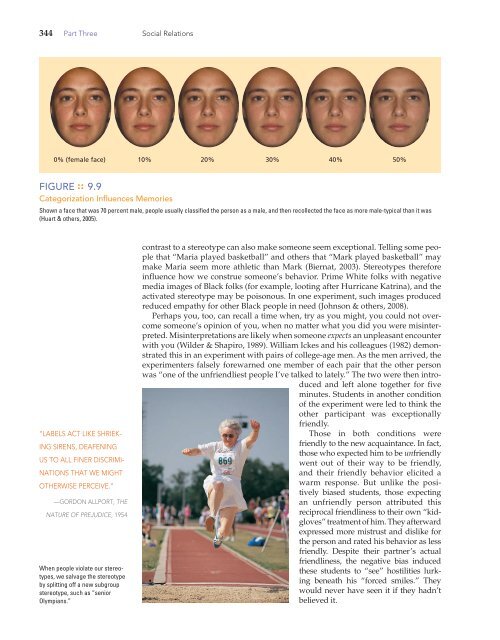Chapter 9: Prejudice: Disliking Others (2947.0K) - Bad Request
Chapter 9: Prejudice: Disliking Others (2947.0K) - Bad Request
Chapter 9: Prejudice: Disliking Others (2947.0K) - Bad Request
Create successful ePaper yourself
Turn your PDF publications into a flip-book with our unique Google optimized e-Paper software.
344 Part Three Social Relations<br />
0% (female face) 10% 20% 30% 40% 50%<br />
FIGURE :: 9.9<br />
Categorization Influences Memories<br />
Shown a face that was 70 percent male, people usually classified the person as a male, and then recollected the face as more male-typical than it was<br />
(Huart & others, 2005).<br />
“LABELS ACT LIKE SHRIEK-<br />
ING SIRENS, DEAFENING<br />
US TO ALL FINER DISCRIMI-<br />
NATIONS THAT WE MIGHT<br />
OTHERWISE PERCEIVE.”<br />
—GORDON ALLPORT, THE<br />
NATURE OF PREJUDICE, 1954<br />
When people violate our stereotypes,<br />
we salvage the stereotype<br />
by splitting off a new subgroup<br />
stereotype, such as “senior<br />
Olympians.”<br />
contrast to a stereotype can also make someone seem exceptional. Telling some people<br />
that “Maria played basketball” and others that “Mark played basketball” may<br />
make Maria seem more athletic than Mark (Biernat, 2003). Stereotypes therefore<br />
influence how we construe someone’s behavior. Prime White folks with negative<br />
media images of Black folks (for example, looting after Hurricane Katrina), and the<br />
activated stereotype may be poisonous. In one experiment, such images produced<br />
reduced empathy for other Black people in need (Johnson & others, 2008).<br />
Perhaps you, too, can recall a time when, try as you might, you could not overcome<br />
someone’s opinion of you, when no matter what you did you were misinterpreted.<br />
Misinterpretations are likely when someone expects an unpleasant encounter<br />
with you (Wilder & Shapiro, 1989). William Ickes and his colleagues (1982) demonstrated<br />
this in an experiment with pairs of college-age men. As the men arrived, the<br />
experimenters falsely forewarned one member of each pair that the other person<br />
was “one of the unfriendliest people I’ve talked to lately.” The two were then introduced<br />
and left alone together for five<br />
minutes. Students in another condition<br />
of the experiment were led to think the<br />
other participant was exceptionally<br />
friendly.<br />
Those in both conditions were<br />
friendly to the new acquaintance. In fact,<br />
those who expected him to be un friendly<br />
went out of their way to be friendly,<br />
and their friendly behavior elicited a<br />
warm response. But unlike the positively<br />
biased students, those expecting<br />
an unfriendly person attributed this<br />
reciprocal friendliness to their own “kidgloves”<br />
treatment of him. They afterward<br />
expressed more mistrust and dislike for<br />
the person and rated his behavior as less<br />
friendly. Despite their partner’s actual<br />
friendliness, the negative bias induced<br />
these students to “see” hostilities lurking<br />
beneath his “forced smiles.” They<br />
would never have seen it if they hadn’t<br />
believed it.

















